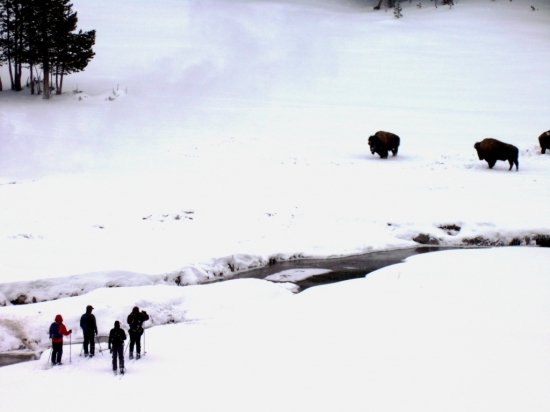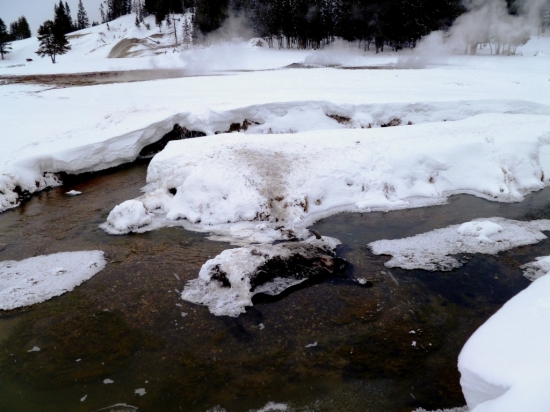Journey to Dreamland
A Late Winter Explorationby Dr. Nathan Varley
March 29, 2013
First grizzly sighting of the year! It was not a large bear, just rooting around in the thermal basins of Mary Bay. Its activity drew a crowd of ravens as if there was a carcass there. But there was not and soon he moved on. The bison nearby were not concerned in the least. They stood in the steam clouds with their lips to the ground grazing imperceptible vegetation.Soon we were on skis pulling our sleds heavily laden with food, fuel, and research supplies. I was accompanying a Utah State University research team whose efforts had in effect spanned 15 years of late winter monitoring in the Pelican Valley. The bison herd in the valley had dwindled through those years to what numbered less than 100. All of them were bulls, too. The cow and calf groups I used to see a decade ago, which alone were some 80 strong, were now gone. The reason? That was among the objectives of these investigations. Speculation ranged from improved access to habitat created by the network of groomed roads to a high density of predators like wolves and grizzlies.
Sun-baked, wind-blown snow blanketed the valley making for a smooth surface to pull our sleds. Wind howled with the occasional snow flurry. It seemed like spring weather, but winter still held with certainty this land in its icy grips.
My part of it was easy. Well, at least straight-forward. Nothing about pulling the heavy sled up a long, steep hill was easy. It was laborious and at times the sled had to be threaded between lodgepole saplings densely configured on a slope that thoroughly burned in 1994. Some of the saplings were now 20’ tall having grown a foot each year. My sled kept sliding into deep holes, sinking to the bottom of massive tree wells. Branches of the tree fought every effort to raise the sled. Haggard and soar, I finally plodded and collapsed at the top.
My experience there could not be more the opposite of the ascent. A wonderful camp had been carved out of the snowbanks by the team. Most every comfort was there, from a small wood stove in the cook tent, to deep snow shelters dug into the cornice. I bedded each night in the latter, snug and quiet, most oblivious to the sometimes extreme conditions outside. I slept like a rock.
There is nothing short of the description ‘dreamland’ that can describe the realm of this remote setting. From this camp, the valley stretched to the east and west, on the latter end, clear to the shores of Yellowstone Lake, where Stevenson and Dot Islands protrude from the frozen expanse. On a clear day, I could see the Red Mountains, and the Tetons far to the south. To the north, the steam clouds rose from the timbered hills at fancifully-named places such as Astringent Creek and The Mushpots. Pelican Cone, Dunraven Peak, and Mount Washburn poked up at the fringe of the Mirror Plateau, a massive landform that stood tall and sprawling between me and the Northern Range.
Days here were filled with intrigue and discovery. Each day the team documented the activities and locations of the bull bison as they mined the grasses deep below snow. Their fastidiousness was a marvel. Each day I caught a glimpse of the wolf pack, the remnant of the once-mighty Mollies who ravaged the packs of the Northern Range last year as a force of ~18. Dwindled now to only 3, the group consisted of the venerable female 686, her younger sister 779, and a large, lanky gray male. Most other surviving members of the once-formidable pack now make up the bulk of the Junction Butte pack.
Pack movements revolved around a bison that had died in the upper stretches of Pelican Creek. We skied out through intermittent young and old timber to investigate the carcass, but could not determine how it had died. Only that it rested in the creek, awash in water rank with sulfur. Wolf tracks paved the adjoining banks.
Coming and going from this area we crossed the tracks of a single wolf. The team had spotted this individual trailing the 3, and identified him as 860, a young gray male collared with the Lamar pack east of the park in Wyoming. It was not clear if 860 was a Lamar by birth or had joined the pack during their time in the east. He was on his own now, perhaps looking to join this small group, but by the end of my time here he had left the valley, traveling alone far to the northeast.
My last grizzly sighting occurred on the return trip. Walking on the ski trail through the open valley, a huge bruin appeared and was not about to diverge from our intended path. Even after he saw us ahead, resting, he lumbered on directly. With a burst of excitement we skied off-route quickly and gave this traveler a wide berth. He went past without incident, occasionally looking up, and raising his massive nose to try to wind these strange beings, as he must have perceived us with our skis, poles, and sleds.





